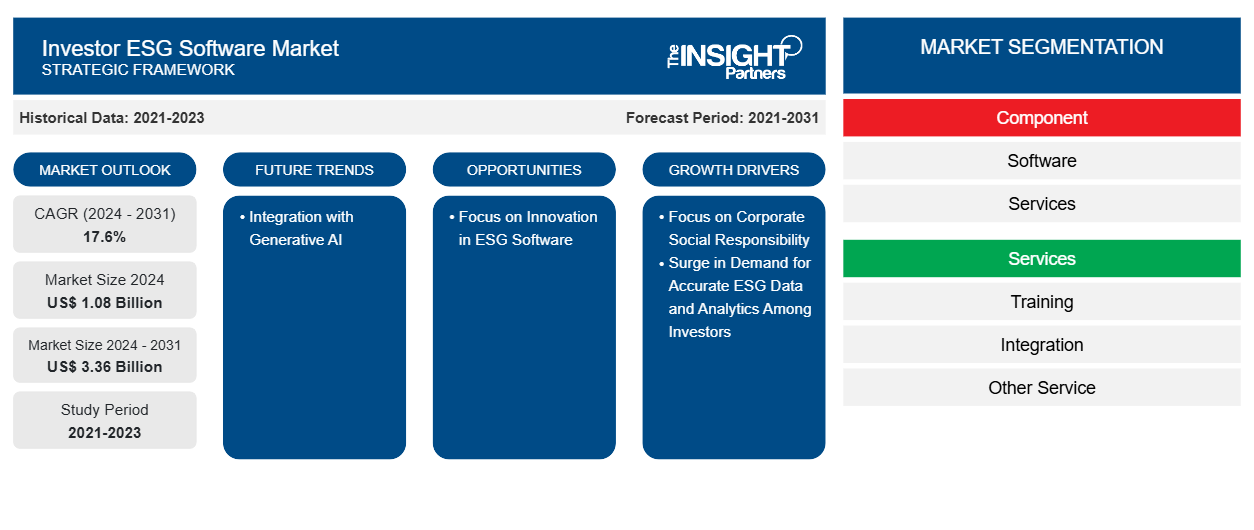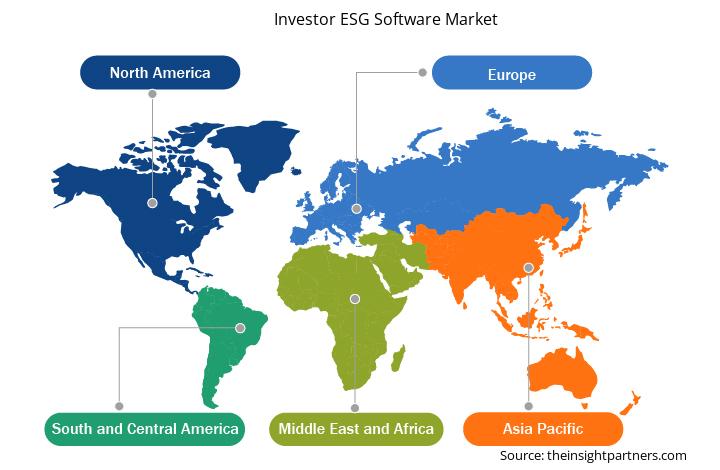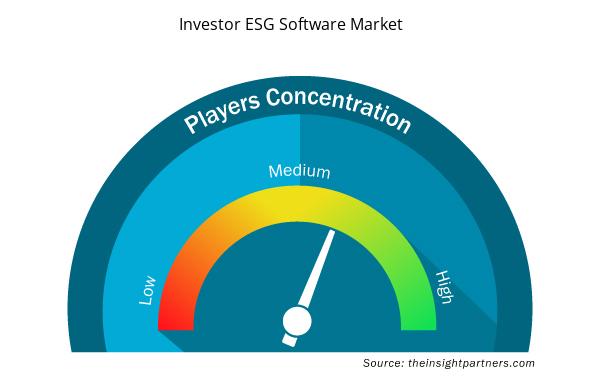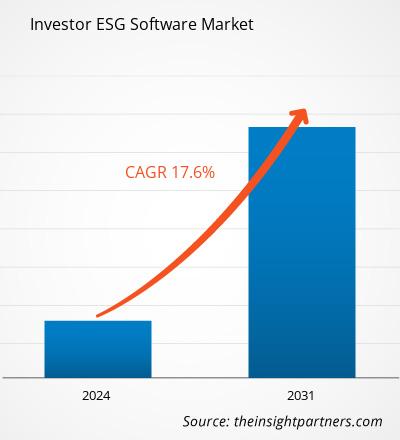Der Markt für ESG-Software für Investoren hatte im Jahr 2024 ein Volumen von 1,08 Milliarden US-Dollar und dürfte bis 2031 ein Volumen von 3,36 Milliarden US-Dollar erreichen. Von 2024 bis 2031 wird mit einer durchschnittlichen jährlichen Wachstumsrate (CAGR) von 17,6 % gerechnet. Die Integration von ESG-Software mit generativer KI dürfte in den kommenden Jahren neue Trends auf den Markt bringen.
ESG-Software-Marktanalyse für Investoren
Der Markt für ESG-Software für Investoren verzeichnet ein deutliches Wachstum. Dies ist auf die steigende Nachfrage nach verantwortungsvollem Investieren, die zunehmende Besorgnis über Klimawandel, soziale Probleme und Governance-Praktiken sowie den Bedarf an Transparenz und Einhaltung sich entwickelnder globaler ESG-Standards zurückzuführen. Die Nachfrage nach ESG-Software für Investoren wird von institutionellen Anlegern, Vermögensverwaltern und Finanzinstituten getrieben, die ESG-Faktoren in ihre Entscheidungsprozesse integrieren möchten. Faktoren wie der Fokus auf unternehmerische Gesellschaftsverantwortung und die wachsende Nachfrage der Anleger nach präzisen ESG-Daten und -Analysen treiben den Markt für ESG-Software für Investoren ebenfalls an. Darüber hinaus schaffen der Fokus auf Innovation bei ESG-Software und die Integration mit generativer KI lukrative Wachstumsmöglichkeiten für die Akteure im Markt für ESG-Software für Investoren im Prognosezeitraum.
Marktübersicht für ESG-Software für Investoren
Unternehmen nutzen ESG-Software für Investoren, um Fragebögen anzupassen und die Datenerfassung zu optimieren. Dies ermöglicht die Aggregation präziser und vergleichbarer ESG-Leistungskennzahlen. Diese Software-as-a-Service-Plattform unterstützt ESG-Initiativen und hilft Unternehmen, ihren Wert zu maximieren und Investitionen zu bewerten. ESG-Investing, auch nachhaltiges Investieren genannt, konzentriert sich auf die Identifizierung von Faktoren, die verantwortungsvolle, nachhaltige oder ethische Investitionen definieren. ESG-Software wird sowohl von Investoren als auch von Kapitalmarktunternehmen genutzt, um das Unternehmensverhalten zu bewerten und Erkenntnisse für die Prognose der zukünftigen finanziellen Entwicklung zu liefern. Viele Unternehmen implementieren diese Softwarelösungen, um Risiken im Zusammenhang mit ihrem Betrieb, ihren Geschäftsbeziehungen, ihrem Vermögen und ihren Investitionen zu minimieren.
ESG-Plattformen unterstützen die Anlageanalyse und ermöglichen fundiertere und strategischere Anlageentscheidungen. ESG-Software für Investoren ist darauf zugeschnitten, Anlegern bei der Bewertung, Verfolgung und Steuerung der ESG-Performance ihrer Portfolios und Anlageentscheidungen zu helfen. Diese Plattformen bieten datenbasierte Einblicke, Analysen und Berichte zu verschiedenen ESG-Kennzahlen und ermöglichen es Anlegern, ihre Anlagestrategien an Nachhaltigkeitszielen und regulatorischen Anforderungen auszurichten.
Passen Sie diesen Bericht Ihren Anforderungen an
Sie erhalten kostenlos Anpassungen an jedem Bericht, einschließlich Teilen dieses Berichts oder einer Analyse auf Länderebene, eines Excel-Datenpakets sowie tolle Angebote und Rabatte für Start-ups und Universitäten
ESG-Softwaremarkt für Investoren:

- Informieren Sie sich über die wichtigsten Markttrends in diesem Bericht.Dieses KOSTENLOSE Beispiel umfasst Datenanalysen, von Markttrends bis hin zu Schätzungen und Prognosen.
Treiber und Chancen des ESG-Softwaremarkts für Investoren
Fokus auf Corporate Social Responsibility
Die Verabschiedung der Richtlinie zur Nachhaltigkeitsberichterstattung von Unternehmen (CSRD) stellt einen bedeutenden regulatorischen Wandel dar, der die Nachfrage nach ESG-Software für Investoren deutlich steigert. Die CSRD, die im Januar 2023 die Richtlinie zur nichtfinanziellen Berichterstattung (NFRD) ersetzte, erweitert den Umfang der verpflichtenden ESG-Berichterstattung innerhalb der Europäischen Union drastisch. Unter der NFRD waren rund 11.000 große Unternehmen verpflichtet, ESG-Informationen offenzulegen. Die CSRD weitet diese Verpflichtung jedoch auf rund 50.000 Unternehmen aus, die rund 75 % des Gesamtumsatzes aller EU-Unternehmen ausmachen. Dies umfasst sowohl Großkonzerne als auch börsennotierte kleine und mittlere Unternehmen (KMU), wodurch der Umfang der ESG-Offenlegungen und Compliance-Anforderungen erheblich erweitert wird. Die CSRD schreibt Unternehmen vor, detaillierte Informationen zu sozialen, ökologischen und Governance-Faktoren offenzulegen, die Bereiche wie Menschenrechte, Klimarisiken, Biodiversität und Lieferkettentransparenz abdecken. Dieser umfassende Berichtsrahmen stellt sicher, dass Unternehmen negative Auswirkungen auf Umwelt und Menschenrechte in Europa und anderen Regionen angehen und mindern. Mit der Durchsetzung dieser neuen Regeln möchte die CSRD die Konsistenz, Vergleichbarkeit und Zuverlässigkeit von ESG-Daten verbessern und sie für Investoren, Aufsichtsbehörden und die breite Öffentlichkeit transparenter und zugänglicher machen.
Fokus auf Innovation bei ESG-Software
Der Fokus auf Innovationen im Bereich ESG-Software dürfte im Prognosezeitraum zahlreiche Wachstumschancen für den ESG-Softwaremarkt für Investoren eröffnen. Da die Nachfrage nach transparenten, präzisen und umsetzbaren ESG-Daten weiter steigt, setzen Investoren zunehmend auf fortschrittliche ESG-Softwarelösungen, um fundierte Anlageentscheidungen zu treffen. Die sich entwickelnde Landschaft der Umwelt-, Sozial- und Governance-Faktoren (ESG) erfordert von Investoren Zugang zu umfassenden Echtzeit-Einblicken, die nur innovative Softwaretools bieten können. Innovationen im Bereich ESG-Software beinhalten die Integration modernster Technologien wie Künstlicher Intelligenz (KI), die die Erfassung, Verarbeitung und Analyse von ESG-Daten grundlegend verändern. So kündigte der ESG-Datenlösungsanbieter ESGgo im April 2024 die Einführung seines One-Click Sustainability Report an, eines KI-gestützten Tools, das Unternehmen dabei unterstützt, mühelos Nachhaltigkeitsberichte im Einklang mit regulatorischen Rahmenbedingungen und den Erwartungen der Stakeholder zu erstellen. Laut ESGgo vereinfacht diese neue Lösung den Prozess der Nachhaltigkeitsberichterstattung für Unternehmen und gewährleistet die Einhaltung sich entwickelnder Standards. Die KI-gesteuerte Daten-Engine der Plattform verarbeitet sowohl numerische als auch textbasierte Informationen, berechnet Emissionen und synthetisiert Datensätze, um maßgeschneiderte Nachhaltigkeitsberichte zu erstellen. Diese Fortschritte ermöglichen es Investoren, die Nachhaltigkeitsleistung eines Unternehmens effizienter zu überwachen und zukünftige ESG-Risiken und -Chancen anhand von Echtzeitdaten vorherzusagen. Die Fähigkeit, riesige Datenmengen, oft aus unterschiedlichen Quellen, zu verarbeiten und zu umsetzbaren ESG-Kennzahlen zu synthetisieren, ist ein erheblicher Vorteil für Investoren, die Transparenz und Zuverlässigkeit suchen.
Segmentierungsanalyse des Marktberichts zur ESG-Software für Investoren
Wichtige Segmente, die zur Ableitung der ESG-Softwaremarktanalyse für Investoren beigetragen haben, sind Komponenten, Dienste und Unternehmensgröße.
- Der Markt für ESG-Software für Investoren ist nach Komponenten in Software und Dienstleistungen unterteilt. Das Softwaresegment dominierte den Markt im Jahr 2024.
- Der Markt für ESG-Software für Investoren ist in die Bereiche Schulung, Integration und sonstige Dienstleistungen unterteilt. Das Segment der sonstigen Dienstleistungen hatte im Jahr 2024 den größten Marktanteil.
- Der Markt für ESG-Software für Investoren ist nach Unternehmensgröße in Großunternehmen und KMU unterteilt. Das Segment der Großunternehmen dominierte den Markt im Jahr 2024.
Analyse der Marktanteile von Investor-ESG-Software nach geografischen Gesichtspunkten
- Der Markt für ESG-Software für Investoren ist in fünf Hauptregionen unterteilt: Nordamerika, Europa, Asien-Pazifik (APAC), Naher Osten und Afrika (MEA) sowie Süd- und Mittelamerika. Nordamerika dominierte den Markt im Jahr 2024, gefolgt von Europa und dem Asien-Pazifik-Raum.
- Der nordamerikanische Markt für ESG-Software für Investoren wird im Prognosezeitraum voraussichtlich wachsen. Dies ist auf gestiegene gesetzliche Anforderungen zurückzuführen, beispielsweise auf die geplanten Klima-Offenlegungen der US-Börsenaufsicht SEC. Diese rechtlichen Verpflichtungen erhöhen den Druck auf Vermögensverwalter und institutionelle Anleger, ESG-Aspekte und -Regeln in ihren Entscheidungsprozessen zu berücksichtigen. Darüber hinaus steigern die zunehmende Bedeutung von Nachhaltigkeit und die wachsende Sorge um den Klimawandel die Nachfrage von Investoren und Stakeholdern nach ESG-Software für klare, datenbasierte Erkenntnisse. Diese Erkenntnisse unterstützen sie bei der effektiven Bewertung der ESG-Performance von Unternehmen. Die Software erhöht die Rechenschaftspflicht der Unternehmen, indem sie ESG-Reporting, Compliance-Tracking und Risikobewertung in Echtzeit ermöglicht.
- Regierungen verschiedener europäischer Länder ergreifen Maßnahmen wie die Verordnung über nachhaltigkeitsbezogene Offenlegungspflichten im Finanzdienstleistungssektor (SFDR) und die EU-Taxonomie-Verordnung, um die Nachhaltigkeit in der Geschäftstätigkeit zu fördern. Diese Anforderungen verpflichten Vermögensverwalter und institutionelle Anleger, die ESG-Auswirkungen ihrer Investitionen offenzulegen und zu bewerten. Dies führt zu einem verstärkten Einsatz technologisch fortschrittlicher ESG-Software, die Compliance und Datenmanagement ermöglicht. Darüber hinaus haben europäische Investoren ihre nachhaltigen Investitionen ausgeweitet, um die Green-Deal-Ziele der Region zu unterstützen. Dies erhöht die Nachfrage nach ESG-Software für Investoren, die Datenmanagement und fundierte Entscheidungen unterstützt.
Regionale Einblicke in den ESG-Softwaremarkt für Investoren
Die Analysten von Insight Partners haben die regionalen Trends und Faktoren, die den Markt für Investor-ESG-Software im Prognosezeitraum beeinflussen, ausführlich erläutert. In diesem Abschnitt werden auch die Marktsegmente und die geografische Lage von Investor-ESG-Software in Nordamerika, Europa, Asien-Pazifik, dem Nahen Osten und Afrika sowie Süd- und Mittelamerika erläutert.

- Erhalten Sie regionale Daten zum ESG-Softwaremarkt für Investoren
Umfang des Marktberichts zur ESG-Software für Investoren
| Berichtsattribut | Details |
|---|---|
| Marktgröße im Jahr 2024 | 1,08 Milliarden US-Dollar |
| Marktgröße bis 2031 | 3,36 Milliarden US-Dollar |
| Globale CAGR (2024 – 2031) | 17,6 % |
| Historische Daten | 2021-2023 |
| Prognosezeitraum | 2021–2031 |
| Abgedeckte Segmente | Nach Komponente
|
| Abgedeckte Regionen und Länder | Nordamerika
|
| Marktführer und wichtige Unternehmensprofile |
|
Dichte der Marktteilnehmer für ESG-Software für Investoren: Auswirkungen auf die Geschäftsdynamik verstehen
Der Markt für ESG-Software für Investoren wächst rasant. Dies wird durch die steigende Endnutzernachfrage aufgrund veränderter Verbraucherpräferenzen, technologischer Fortschritte und eines stärkeren Bewusstseins für die Produktvorteile vorangetrieben. Mit der steigenden Nachfrage erweitern Unternehmen ihr Angebot, entwickeln Innovationen, um den Bedürfnissen der Verbraucher gerecht zu werden, und nutzen neue Trends, was das Marktwachstum weiter ankurbelt.
Die Marktteilnehmerdichte beschreibt die Verteilung der in einem bestimmten Markt oder einer bestimmten Branche tätigen Unternehmen. Sie gibt an, wie viele Wettbewerber (Marktteilnehmer) in einem bestimmten Marktraum im Verhältnis zu dessen Größe oder Gesamtmarktwert präsent sind.
Die wichtigsten Unternehmen, die auf dem ESG-Softwaremarkt für Investoren tätig sind, sind:
- MSCI
- Workiva Inc.
- Morningstar Inc.
- London Stock Exchange Group plc
- Cority Software Inc
- Prophix Software Inc.
Haftungsausschluss : Die oben aufgeführten Unternehmen sind nicht in einer bestimmten Reihenfolge aufgeführt.

- Überblick über die wichtigsten Akteure auf dem Markt für ESG-Software für Investoren
Neuigkeiten und aktuelle Entwicklungen zum ESG-Softwaremarkt für Investoren
Der Markt für ESG-Software für Investoren wird durch die Erhebung qualitativer und quantitativer Daten aus Primär- und Sekundärforschung bewertet. Dazu zählen wichtige Unternehmenspublikationen, Verbandsdaten und Datenbanken. Nachfolgend sind einige Entwicklungen im Markt für ESG-Software für Investoren aufgeführt:
- Cority gab bekannt, dass alle Kunden, die eine seiner Nachhaltigkeitslösungen nutzen, im Jahr 2025 auf die SaaS-basierte und integrierte CorityOne-Plattform des Unternehmens umgestellt werden. Dieses Upgrade basiert auf der bestehenden Technologie, der Kunden seit über einem Jahrzehnt für ihr Nachhaltigkeitsmanagement vertrauen, und wird mehrere Lösungen zu einem nahtlosen, verbesserten Benutzererlebnis mit erweiterter Funktionalität vereinen, Abläufe weiter rationalisieren und die Datenintegration verbessern.
(Quelle: Cority Software Inc, Pressemitteilung, August 2024)
- Sphera gab die Übernahme von SupplyShift bekannt, einem Softwareunternehmen für nachhaltige Lieferketten, das Unternehmen den Aufbau transparenter, verantwortungsvoller und belastbarer Lieferketten ermöglicht. Die Übernahme erweitert das Lieferkettenangebot des führenden ESG-Unternehmens um erweiterte Funktionen für Lieferantenmapping, -bewertung und -rückverfolgbarkeit und unterstützt Kunden so beim Aufbau nachhaltiger Lieferketten.
(Quelle: Sphera Solutions, Inc., Pressemitteilung, Januar 2024)
Abdeckung und Ergebnisse des ESG-Software-Marktberichts für Investoren
Die Studie „Marktgröße und Prognose für ESG-Software für Investoren (2021–2031)“ bietet eine detaillierte Analyse des Marktes, die die unten genannten Bereiche abdeckt:
- Marktgröße und Prognose für Investor-ESG-Software auf globaler, regionaler und Länderebene für alle wichtigen Marktsegmente, die im Rahmen des Berichts abgedeckt sind
- Markttrends für ESG-Software für Investoren sowie Marktdynamiken wie Treiber, Hemmnisse und wichtige Chancen
- Detaillierte PEST- und SWOT-Analyse
- Marktanalyse für ESG-Software für Investoren, die wichtige Markttrends, globale und regionale Rahmenbedingungen, wichtige Akteure, Vorschriften und aktuelle Marktentwicklungen umfasst
- Branchenlandschafts- und Wettbewerbsanalyse mit Marktkonzentration, Heatmap-Analyse, prominenten Akteuren und aktuellen Entwicklungen für den ESG-Softwaremarkt für Investoren
- Detaillierte Firmenprofile
- Historische Analyse (2 Jahre), Basisjahr, Prognose (7 Jahre) mit CAGR
- PEST- und SWOT-Analyse
- Marktgröße Wert/Volumen – Global, Regional, Land
- Branche und Wettbewerbsumfeld
- Excel-Datensatz



Report Coverage
Revenue forecast, Company Analysis, Industry landscape, Growth factors, and Trends

Segment Covered
This text is related
to segments covered.

Regional Scope
North America, Europe, Asia Pacific, Middle East & Africa, South & Central America

Country Scope
This text is related
to country scope.
Häufig gestellte Fragen
Focus on corporate social responsibility, and surge in demand for accurate ESG data and analytics among investors are the major factors that propel the global investor ESG software market.
The global investor ESG software market is expected to reach US$ 3.36 billion by 2031.
The global Investor ESG software market was estimated to be US$ 1.08 billion in 2024 and is expected to grow at a CAGR of 17.6% during the forecast period 2025 – 2031.
The key players holding majority shares in the global investor ESG software market are MSCI, FactSet, Workiva Inc., SAP SE, and Bloomberg Finance L.P.
The incremental growth expected to be recorded for the global investor ESG software market during the forecast period is US$ 2.27 billion.
Integration with Generative AI is anticipated to play a significant role in the global investor ESG software market in the coming years.
Trends and growth analysis reports related to Technology, Media and Telecommunications : READ MORE..
The List of Companies - Investor ESG Software Market
- MSCI
- Workiva Inc.
- Morningstar Sustainalytics
- London Stock Exchange Group plc
- Cority
- Prophix Software Inc.
- SAP SE
- Sphera
- FactSet
- Bloomberg Finance L.P.
The Insight Partners performs research in 4 major stages: Data Collection & Secondary Research, Primary Research, Data Analysis and Data Triangulation & Final Review.
- Data Collection and Secondary Research:
As a market research and consulting firm operating from a decade, we have published and advised several client across the globe. First step for any study will start with an assessment of currently available data and insights from existing reports. Further, historical and current market information is collected from Investor Presentations, Annual Reports, SEC Filings, etc., and other information related to company’s performance and market positioning are gathered from Paid Databases (Factiva, Hoovers, and Reuters) and various other publications available in public domain.
Several associations trade associates, technical forums, institutes, societies and organization are accessed to gain technical as well as market related insights through their publications such as research papers, blogs and press releases related to the studies are referred to get cues about the market. Further, white papers, journals, magazines, and other news articles published in last 3 years are scrutinized and analyzed to understand the current market trends.
- Primary Research:
The primarily interview analysis comprise of data obtained from industry participants interview and answers to survey questions gathered by in-house primary team.
For primary research, interviews are conducted with industry experts/CEOs/Marketing Managers/VPs/Subject Matter Experts from both demand and supply side to get a 360-degree view of the market. The primary team conducts several interviews based on the complexity of the markets to understand the various market trends and dynamics which makes research more credible and precise.
A typical research interview fulfils the following functions:
- Provides first-hand information on the market size, market trends, growth trends, competitive landscape, and outlook
- Validates and strengthens in-house secondary research findings
- Develops the analysis team’s expertise and market understanding
Primary research involves email interactions and telephone interviews for each market, category, segment, and sub-segment across geographies. The participants who typically take part in such a process include, but are not limited to:
- Industry participants: VPs, business development managers, market intelligence managers and national sales managers
- Outside experts: Valuation experts, research analysts and key opinion leaders specializing in the electronics and semiconductor industry.
Below is the breakup of our primary respondents by company, designation, and region:

Once we receive the confirmation from primary research sources or primary respondents, we finalize the base year market estimation and forecast the data as per the macroeconomic and microeconomic factors assessed during data collection.
- Data Analysis:
Once data is validated through both secondary as well as primary respondents, we finalize the market estimations by hypothesis formulation and factor analysis at regional and country level.
- Macro-Economic Factor Analysis:
We analyse macroeconomic indicators such the gross domestic product (GDP), increase in the demand for goods and services across industries, technological advancement, regional economic growth, governmental policies, the influence of COVID-19, PEST analysis, and other aspects. This analysis aids in setting benchmarks for various nations/regions and approximating market splits. Additionally, the general trend of the aforementioned components aid in determining the market's development possibilities.
- Country Level Data:
Various factors that are especially aligned to the country are taken into account to determine the market size for a certain area and country, including the presence of vendors, such as headquarters and offices, the country's GDP, demand patterns, and industry growth. To comprehend the market dynamics for the nation, a number of growth variables, inhibitors, application areas, and current market trends are researched. The aforementioned elements aid in determining the country's overall market's growth potential.
- Company Profile:
The “Table of Contents” is formulated by listing and analyzing more than 25 - 30 companies operating in the market ecosystem across geographies. However, we profile only 10 companies as a standard practice in our syndicate reports. These 10 companies comprise leading, emerging, and regional players. Nonetheless, our analysis is not restricted to the 10 listed companies, we also analyze other companies present in the market to develop a holistic view and understand the prevailing trends. The “Company Profiles” section in the report covers key facts, business description, products & services, financial information, SWOT analysis, and key developments. The financial information presented is extracted from the annual reports and official documents of the publicly listed companies. Upon collecting the information for the sections of respective companies, we verify them via various primary sources and then compile the data in respective company profiles. The company level information helps us in deriving the base number as well as in forecasting the market size.
- Developing Base Number:
Aggregation of sales statistics (2020-2022) and macro-economic factor, and other secondary and primary research insights are utilized to arrive at base number and related market shares for 2022. The data gaps are identified in this step and relevant market data is analyzed, collected from paid primary interviews or databases. On finalizing the base year market size, forecasts are developed on the basis of macro-economic, industry and market growth factors and company level analysis.
- Data Triangulation and Final Review:
The market findings and base year market size calculations are validated from supply as well as demand side. Demand side validations are based on macro-economic factor analysis and benchmarks for respective regions and countries. In case of supply side validations, revenues of major companies are estimated (in case not available) based on industry benchmark, approximate number of employees, product portfolio, and primary interviews revenues are gathered. Further revenue from target product/service segment is assessed to avoid overshooting of market statistics. In case of heavy deviations between supply and demand side values, all thes steps are repeated to achieve synchronization.
We follow an iterative model, wherein we share our research findings with Subject Matter Experts (SME’s) and Key Opinion Leaders (KOLs) until consensus view of the market is not formulated – this model negates any drastic deviation in the opinions of experts. Only validated and universally acceptable research findings are quoted in our reports.
We have important check points that we use to validate our research findings – which we call – data triangulation, where we validate the information, we generate from secondary sources with primary interviews and then we re-validate with our internal data bases and Subject matter experts. This comprehensive model enables us to deliver high quality, reliable data in shortest possible time.

 Holen Sie sich ein kostenloses Muster für diesen Bericht
Holen Sie sich ein kostenloses Muster für diesen Bericht